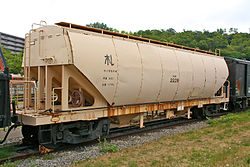History
This section needs additional citations for verification .(July 2022) |


The grain trade is probably nearly as old as grain growing, going back to the Neolithic Revolution (around 9,500 BCE). Wherever there is a scarcity of land (e.g. cities), people must bring in food from outside to sustain themselves, either by force or by trade. However, many farmers throughout history (and today) have operated at the subsistence level, meaning they produce for household needs and have little leftover to trade. The goal for such farmers is not to specialize in one crop and grow a surplus of it, but rather to produce everything their family needs and become self-sufficient. Only in places and eras where production is geared towards producing a surplus for trade (commercial agriculture) does a major grain trade become possible.
Classical world
In the ancient world, grain regularly flowed from the hinterlands to the cores of great empires: maize in ancient Mexico, rice in ancient China, and wheat and barley in the ancient Near East. With this came improved technologies for storing and transporting grains; the Hebrew Bible makes frequent mention of ancient Egypt's massive grain silos.
Merchant shipping was important for the carriage of grain in the classical period (and continues to be so). A Roman merchant ship could carry a cargo of grain the length of the Mediterranean for the cost of moving the same amount 15 kilometres by land. The large cities of the time could not exist without the supplies delivered. For example, in the first three centuries AD, Rome consumed about 150,000 tons of Egyptian grain each year. [5] : 297
During the classical age, the unification of China, and the pacification of the Mediterranean basin by the Roman Empire created vast regional markets in commodities at either end of Eurasia. The grain supply to the city of Rome was considered to be of the utmost strategic importance to Roman generals and politicians.

In Europe, with the fall of the Roman Empire and the rise of feudalism, many farmers were reduced to a subsistence level, producing only enough to fulfill their obligation to their lord and the Church, with little for themselves, and even less for trading. The little that was traded was moved around locally at regular fairs.
Early modern and modern expansion
A massive expansion in the grain trade occurred when Europeans were able to bring millions of square kilometers of new land under cultivation in the Americas, Russia, and Australia, an expansion starting in the fifteenth and lasting into the twentieth century. In addition, the consolidation of farmland in Britain and Eastern Europe, and the development of railways and the steamship shifted trade from local to more international patterns.
During this time, debate over tariffs and free trade in grain was fierce. Poor industrial workers relied on cheap bread for sustenance, but farmers wanted their government to create a higher local price to protect them from cheap foreign imports, resulting in legislation such as Britain's Corn Laws. [6]

As Britain and other European countries industrialized and the urban population increased, they became net importers of grain from the various breadbaskets of the world. In many parts of Europe, as serfdom was abolished, great estates were accompanied by many inefficient smallholdings, but in the newly colonized regions massive operations were available to not only great nobles, but also to the average farmer. In the United States and Canada, the Homestead Act and the Dominion Lands Act allowed pioneers on the western plains to gain tracts of 160 acres (65 ha) or more for little or no fee. This moved grain production, and hence trading, to a much more massive scale. Grain elevators were built to take in farmers' produce and move it out via the railways to port. Transportation costs were a major concern for farmers in remote regions, however, and any technology that allowed the easier movement of grain was of great assistance; meanwhile, farmers in Europe struggled to remain competitive while operating on a much smaller scale.

20th century changes

During the Great Depression, farmers in Australia and Canada reacted against the pricing power of the large grain-handling and shipping companies. Their governments created the Australian Wheat Board and the Canadian Wheat Board as monopsony marketing boards, buying all the wheat in those countries for export. Together, those two boards controlled a large percentage of the world's grain trade in the mid-20th century. Additionally, farmers' cooperatives such the wheat pools became a popular alternative to the major grain companies.
At the same time in the Soviet Union and soon after in China, disastrous collectivization programs effectively turned the world's largest farming nations into net importers of grain.

By the second half of the 20th century, the grain trade was divided between a few state-owned and privately owned giants. The state giants were Exportkhleb of the Soviet Union, the Canadian Wheat Board, the Australian Wheat Board, the Australian Barley Board, and so on. The largest private companies, known as the "big five", were Cargill, Continental, Louis Dreyfus, Bunge, and Andre, an older European company not to be confused with the more recent André Maggi Group from Brazil.
In 1972, the Soviet Union's wheat crop failed. To prevent shortages in their country, Soviet authorities were able to buy most of the surplus American harvest through private companies without the knowledge of the United States government. This drove up prices across the world, and was dubbed the "great grain robbery" by critics. Subsequently, Americans paid greater attention to large trading companies.
By contrast, in 1980, the US government attempted to use its food power to punish the Soviet Union for its invasion of Afghanistan with an embargo on grain exports. This was seen as a failure in terms of foreign policy and negatively impacted American farmers.



